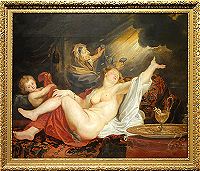 click to enlarge |
DANAE AND THE SHOWER OF GOLD Studio of Peter Paul Rubens SN 220, oil on canvas From "The Pages" |
ARTIST:
Peter Paul Rubens’ Protestant family had fled to Germany to escape religious persecution; Peter was born in Cologne, the youngest of 5 children. Shortly before the father’s death, the family embraced Catholicism and returned to Antwerp, where Peter began his artistic training at 14. Tall, handsome, quiet and agreeable, young Peter had mastered 7 languages before setting up in business as an artist. He was also a classical scholar.
At 23 he went to Italy, becoming court painter to the Duke of Mantua. With his reputation made, he returned to Antwerp where he maintained a large studio of assistants and collaborators, among whom were Van Dyck and Jordaens. His ruler, Isabella Clara Eugenia, was his loyal patron for whom he undertook many diplomatic missions.
Rubens’ private life was equally successful. At 32 he married Isabella Brant, a lush 17-year-old Flemish girl with whom he had 2 children. Their home was a remodeled palace in which they entertained royally, but otherwise lived temperately. Rubens’ typical day included mass at 4 a.m. Then he painted through the good light, followed by time outdoors with his horses and children. At night he discussed affairs of state with visiting dignitaries, or did his writing.
After Isabella’s death, Rubens remained a widower for 4 years, then married the most beautiful girl in Antwerp. He was 52, she was 16. They retired to a new country home where he fathered 4 more children and spent 10 happy years before his death.
Rubens celebrated each of his 2 marriages with beautiful family portraits. He kept his studio busy for 15 years, turning out some 3000 paintings. Meanwhile he wrote books on architecture and gems, and served his ruler well in government. Talented, genial, and honest, he was truly a man for all seasons!
SUBJECT: The story comes from mythology. King Acrisius of Argos had a beautiful daughter, Danae. When it was prophesied that a son of hers would kill him, the distraught father imprisoned her in a bronze chamber underground in an effort to forestall a marriage and eventual childbirth. However, that well-known seducer Zeus transformed himself into a shower of gold coins which slid into her chamber. As a result of that encounter, Danae bore a son, Perseus, who did indeed fulfill the prophecy, albeit accidentally. Years later in an athletic contest, Perseus’ discus swerved into the crowd of spectators, striking a fatal blow to Acrisius.
PAINTING:
Rubens presents a luscious nude in surroundings of luxury. Danae’s couch is covered with an exotic oriental rug. The table by her side supports a golden tray and flagon. Her astonished maid attempts to catch the coins that are arriving in a blaze of light, while Cupid tries to cover Danae’s nude body…but succeeds only in emphasizing it. Danae herself seems to welcome such an exciting event to alleviate the boredom of her imprisonment.
The figure of Danae also appears in Rubens’ Abduction of the Daughters of Leucippas…..a good example of transferring a design from one painting to another.
In the earlier Medieval period, Danae’s story was given a moral interpretation: Danae was seen as a model of modesty, the bronze chamber symbolizing chastity. Some later Renaissance painters (e.g., Titian & Correggio) preferred a more erotic interpretation – that the gold was payment for sexual favors.